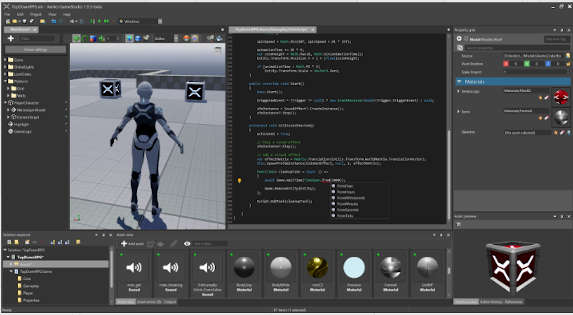| Stride3D - Life beyond Unity? |
| Written by Nikos Vaggalis | |||
| Monday, 27 February 2023 | |||
|
Stride is an opensource C# game engine for realistic rendering and VR. With the recent Unity turmoil can it become a valuable replacement? Let's find out. Stride3D, as said, is open source and at the same time highly modular. It also comes with its own editor that allows you to create and manage the content of your games or applications visually. Of course, it is programmable under C#. . NET in general seems to be the preferred platform for game developers to build their games on. There are several reasons for that:
As far as the choice of C# goes, given the .NET environment, C# is the star of the show. But it's not just that. Because there's a lot of C++ code and libraries out there that your game must interact with, C# is preferred because it has got much better interoperation with that native code (P/Invoke) than other languages such as Java (JNI); also its runtime performs better and is more memory efficient on GPUs. But both of those assumptions could soon be challenged by other parties, as examined in TornadoVM Makes It Possible To Run Java on GPUs and FPGAs. Finally, there's some language semantics, like C# supporting Value types which are highly sought after in game development. And of course the biggest reason of C#'s popularity among the gamedev tribe is that Unity has picked it as its main scripting language. But back to Stride. Stride is considered a lighter equivalent to Unity and it is not a new kid on the block. Its history dates back a decade ago starting life as Paradox 3D, then getting revamped as Xenko and finally assuming its current form as Stride, run by the open source community and under the MIT license.
Stride's main selling points are :
After a lot of time inactive, there's a new major version out, that of 4. 1 which in short brings :
as well as minor bug fixes.
To build from source it requires a hefty list of build requirements which you'll find on its GitHub repo. But when there's an installer bundling everything which supports Windows, Android, iOS, Xbox One, UWP and experimentally Linux, who would go by building it by hand? Now in order to get a foothold in using it to write your own games, you can begin by watching this official playlist of tutorials up on YouTube. In conclusion, given the recent Unity/Iron Source merging that resulted in fallout within the game dev community, prompting it to look for alternatives, maybe it's time for this game engine to pick up the pieces. VVVV Visual Programming Environment has already picked it up as its 3d rendering library of choice. Why don't you too?
More InformationRelated ArticlesTornadoVM Makes It Possible To Run Java on GPUs and FPGAs Memorial University's Intro to Game Programming LWJGL - The Lightweight Java Game Library Version 3.3 Released To be informed about new articles on I Programmer, sign up for our weekly newsletter, subscribe to the RSS feed and follow us on Twitter, Facebook or Linkedin.
Comments
or email your comment to: comments@i-programmer.info |
|||
| Last Updated ( Monday, 27 February 2023 ) |




